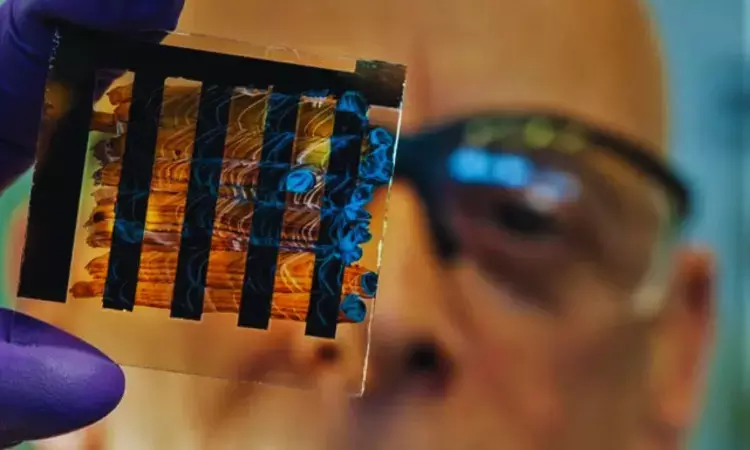- Home
- Medical news & Guidelines
- Anesthesiology
- Cardiology and CTVS
- Critical Care
- Dentistry
- Dermatology
- Diabetes and Endocrinology
- ENT
- Gastroenterology
- Medicine
- Nephrology
- Neurology
- Obstretics-Gynaecology
- Oncology
- Ophthalmology
- Orthopaedics
- Pediatrics-Neonatology
- Psychiatry
- Pulmonology
- Radiology
- Surgery
- Urology
- Laboratory Medicine
- Diet
- Nursing
- Paramedical
- Physiotherapy
- Health news
- Fact Check
- Bone Health Fact Check
- Brain Health Fact Check
- Cancer Related Fact Check
- Child Care Fact Check
- Dental and oral health fact check
- Diabetes and metabolic health fact check
- Diet and Nutrition Fact Check
- Eye and ENT Care Fact Check
- Fitness fact check
- Gut health fact check
- Heart health fact check
- Kidney health fact check
- Medical education fact check
- Men's health fact check
- Respiratory fact check
- Skin and hair care fact check
- Vaccine and Immunization fact check
- Women's health fact check
- AYUSH
- State News
- Andaman and Nicobar Islands
- Andhra Pradesh
- Arunachal Pradesh
- Assam
- Bihar
- Chandigarh
- Chattisgarh
- Dadra and Nagar Haveli
- Daman and Diu
- Delhi
- Goa
- Gujarat
- Haryana
- Himachal Pradesh
- Jammu & Kashmir
- Jharkhand
- Karnataka
- Kerala
- Ladakh
- Lakshadweep
- Madhya Pradesh
- Maharashtra
- Manipur
- Meghalaya
- Mizoram
- Nagaland
- Odisha
- Puducherry
- Punjab
- Rajasthan
- Sikkim
- Tamil Nadu
- Telangana
- Tripura
- Uttar Pradesh
- Uttrakhand
- West Bengal
- Medical Education
- Industry
Increased IOP closely associated with retinal microvascular loss

Increased intraocular pressure (IOP) measurements were linked to quicker rates of total retinal microvascular loss, says an article published in British Journal of Ophthalmology.
Elevated IOP is the most major risk factor for glaucoma, and epidemiological research shows that normal ocular pressure ranges between 10 and 21 mmHg. However, the threshold IOP level at which glaucoma damage starts differs from person to person. In order to assess the link between intraocular pressure and the rate of macula whole image vascular density (wiVD) loss and whole image ganglion cell complex (wiGCC) thinning in glaucoma, Golnoush Mahmoudinezhad and peers undertook this study.
The Diagnostic Innovations in Glaucoma Study included 62 patients, with 59 having primary open-angle glaucoma and 27 having glaucoma suspect eyes, with a mean follow-up of 3.2 years. The vascular density and structural thickness of the same 6 mm GCC scan slab were assessed using optical coherence tomography angiography (OCT-A). To explore the influence of IOP factors on the rate of wiVD and wiGCC change, univariable and multivariable linear mixed models were done for all eyes and a selection of those with peak IOP of 18 mm Hg.
The key findings of this study were:
1. The mean baseline deviation in the visual field (95% CI) was 3.3 dB (4.4 to -2.1).
2. Higher mean IOP (0.07%/year per 1 mm Hg (0.14 to -0.01), p=0.033), peak IOP (0.07%/year per 1 mm Hg (0.13 to -0.02), p=0.004), and IOP fluctuation (IOP SD) (0.17%/year per 1 mm Hg (0.32 to 0.02), p=0.026) were linked to quicker retinal vascular density reduction.
3. Higher mean IOP (0.05 m/year per 1 mm Hg (0.10 to -0.01), p=0.015), peak IOP (0.05 m/year per 1 mm Hg (0.08 to -0.02), p=0.003), and IOP variation (0.112 m/year per 1 mm Hg (0.22 to -0.01), p=0.032) were related with faster wiGCC thinning.
4. Faster wiVD development was linked with higher mean IOP in eyes with a peak IOP of 18 mm Hg (p=0.042).
5. In these eyes, faster wiGCC development was linked with higher mean IOP (p=0.025).
Reference:
Mahmoudinezhad, G., Moghimi, S., Nishida, T., Micheletti, E., Du, K. H., Mohammadzadeh, V., Wu, J.-H., Kamalipour, A., & Weinreb, R. N. (2022). Intraocular pressure increases the rate of macular vessel density loss in glaucoma. In British Journal of Ophthalmology (p. bjo-2022-322261). BMJ. https://doi.org/10.1136/bjo-2022-322261
Neuroscience Masters graduate
Jacinthlyn Sylvia, a Neuroscience Master's graduate from Chennai has worked extensively in deciphering the neurobiology of cognition and motor control in aging. She also has spread-out exposure to Neurosurgery from her Bachelor’s. She is currently involved in active Neuro-Oncology research. She is an upcoming neuroscientist with a fiery passion for writing. Her news cover at Medical Dialogues feature recent discoveries and updates from the healthcare and biomedical research fields. She can be reached at editorial@medicaldialogues.in
Dr Kamal Kant Kohli-MBBS, DTCD- a chest specialist with more than 30 years of practice and a flair for writing clinical articles, Dr Kamal Kant Kohli joined Medical Dialogues as a Chief Editor of Medical News. Besides writing articles, as an editor, he proofreads and verifies all the medical content published on Medical Dialogues including those coming from journals, studies,medical conferences,guidelines etc. Email: drkohli@medicaldialogues.in. Contact no. 011-43720751


